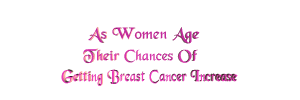
 One in every 217 women will be diagnosed with breast cancer by age 40 One in every 50 women will be diagnosed with breast cancer by age 50 One in every 24 women will be diagnosed with breast cancer by age 60 |
 |
 Source: The National Cancer institute and The American Cancer Society |
Heavy drinking equals high risk. A number of studies over the last decade suggest that even moderate alcohol consumption places women at a 40-to-100 percent increased risk for breast cancer. Breast-feeding has been shown to lower the risk of premenopausal breast cancer. There may be some migration of toxins from breast tissue to breast milk. But the benefits to your child, and you, totally outweigh the risks. |
Fruits and vegetables help protect you from cancer by contributing antioxidants to your body. Broccoli, cauliflower, and cabbage are also thought to lower "bad estrogen" levels. Wash them carefully to decrease pesticide residues Industries that profit from mammograms are pushing them for younger women, and they've duped some powerful women in Congress. But to date,there is no conclusive evidence that routine mammograms reduce the death rate for younger women. Denser tissue makes it difficult to spot tumors. False positives are a problem, leading to unnecessary biopsies, and women who rely on mammograms may neglect self-examination which is easier, less expensive, and quicker in the long-run. Some researchers believe the radiation from mammograms may actually increase a younger woman's risk, which... if you think about it, isn't that hard to believe. Nonetheless, if you feel a lump in your breast, don't hesitate to get one. My mother ignored hers when her doc said that she was under 50 and probably had nothing to worry about... 2 years later she had a lump the size of a doughnut hole... had to have the breast removed and chemo. If the doctor (AND my mother) would have looked into it more she could have saved the breast and her loss of hair from the chemo. |
 Home
Home